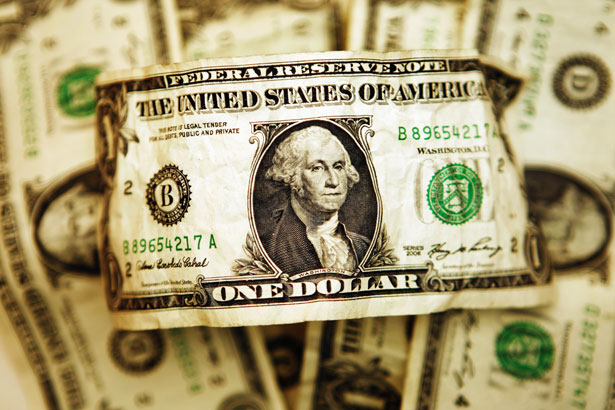
REUTERS/Mark Blinch
Everyone knows the story of Henry Ford more than doubling his production line workers’ pay to $5 a day in January 1914. Ford explained to aghast fellow capitalists that he would be creating customers for his cheap cars, building a new American middle class.
Nearly a century later, in 2005, Walmart CEO Lee Scott called on Congress to raise the minimum wage, since “our customers simply don’t have the money to buy basic necessities between pay checks.” Walmart haters whacked away at Scott for hypocrisy, but he was being perfectly reasonable in identifying what was then and is now America’s number-one problem: a huge chunk of the population barely survives on starvation wages. If you adjust for inflation, median personal income hasn’t moved for almost half a century. Nearly a quarter of US households have zero to negative net worth. It just takes one unlucky turn of the cards—an illness, an accident, a brush with the law—to put them under.
President Obama invokes “the knowledge economy,” putatively replete with well-paying jobs demanding advanced skills in all the high-tech arts that can make America great again. But what is the real economy of tomorrow for most Americans? The Bureau of Labor Statistics (BLS) reckons that by 2020 the overwhelming majority of jobs will still require only a high school diploma or less, and that nearly three-fourths of “job openings due to growth and replacement needs” over the next decade will pay a median wage of less than $35,000 a year, with nearly 30 percent paying a median of about $20,000 (in 2010 dollars).
Right now about 50 million Americans are working in: office and administrative support occupations (median wage of $31,250), sales and related occupations ($24,840), food preparation and serving occupations ($18,900). Not too much knowledge required. The growth jobs of tomorrow, according to the BLS: Childcare workers ($19,430), personal care aides ($19,730), home health aides ($20,610), janitors and cleaners ($22,210), teacher assistants ($23,220), nonconstruction laborers ($23,460), security guards ($23,900) and construction laborers ($29,730).
So what is the best anti-poverty program? Higher wages for the jobs that are out there. The current federal minimum wage is $7.25 per hour. Work a forty-hour week for $7.25 and you end up with $15,080 a year. This is just above the federal poverty line for an individual ($11,000) but well below the line for a family of four ($22,000). And it’s just a bit more than the manufacturer’s recommended retail price for the Ford Fiesta ($13,200), Ford’s cheapest car this year. In 1914 an assembly line worker could buy a Model T with four months’ pay.
Popular
"swipe left below to view more authors"Swipe →
Even though the cost of living has gone up, the federal minimum wage hasn’t moved since 2009, when the last of a series of increases signed into law by George W. Bush kicked in. In 2011 dollars, the minimum wage was more than $10 in 1968, when jobs and pay were peaking for America’s workers.
In November 2008 President-elect Obama promised to “raise the minimum wage to $9.50 an hour by 2011 and index it to inflation to make sure that full-time workers can earn a living wage that allows them to raise their families and pay for basic needs such as food, transportation, and housing.”
It was a pledge to low-paid workers to give them a 30 percent pay hike. Of all Obama’s betrayals, this was one of the bitterest. He never really tried, skittish with fear that he’d be nailed as an inflationeer by the Big Business lobbies and their creatures in Congress. In this cowardice he stands shoulder to shoulder with Mitt Romney, who in January said at a campaign event in New Hampshire that he favored raising the minimum wage automatically each year to keep pace with inflation. A couple of whacks from the Wall Street Journal saw Romney flop on the issue at the start of March.
A smart coalition stretching from American Conservative publisher Ron Unz to James K. Galbraith says a $12 minimum wage makes good sense as long-term stimulus. As Unz points out, “The minimum wage in Ontario, Canada, is currently well over $10 per hour, while in France it now stands at nearly $13. Even more remarkably, Australia recently raised its minimum wage to over $16 per hour, and nonetheless has an unemployment rate of just 5 percent.” Properly enforced, a $12 minimum wage would slow illegal immigration, which is powered by a low-wage economy.
As Galbraith, seizing on Unz’s proposal, wrote, “What would workers do with the raise? They’d spend it, creating jobs for other workers. They’d pay down their mortgages and car loans, getting themselves out of debt.… Women in particular would benefit because they tend to work for lower wages.”
Who’s fighting for the most vital economic issue in American politics today? Senator Tom Harkin’s Rebuild America Act, which he introduced on March 29, calls for raising the minimum wage to $9.80—a 35 percent hike—and pegging the wage to inflation. A day earlier, Ralph Nader flayed Richard Trumka in an open letter to the AFL-CIO president, charging him with giving Obama an “early blanket endorsement,” then, among other failures, running a feeble, low-energy campaign for an inflation-adjusted $10 minimum wage law, even though keeping up with inflation for the federal minimum wage “is historically supported by 70 percent of the people…. What is the AFL-CIO waiting for?… No wonder [Obama] can get away with giving the trade union movement and unorganized workers the back of his hand.”
Most progressives watch with complacency the suicidal Republicans heading over the cliff. Let them step back and look at the desperation of millions of Americans today. Will they, like Trumka, stay loyal and inert right through to November?
![]() Take Action: Tell Your Senators to Pass the Rebuild America Act
Take Action: Tell Your Senators to Pass the Rebuild America Act


